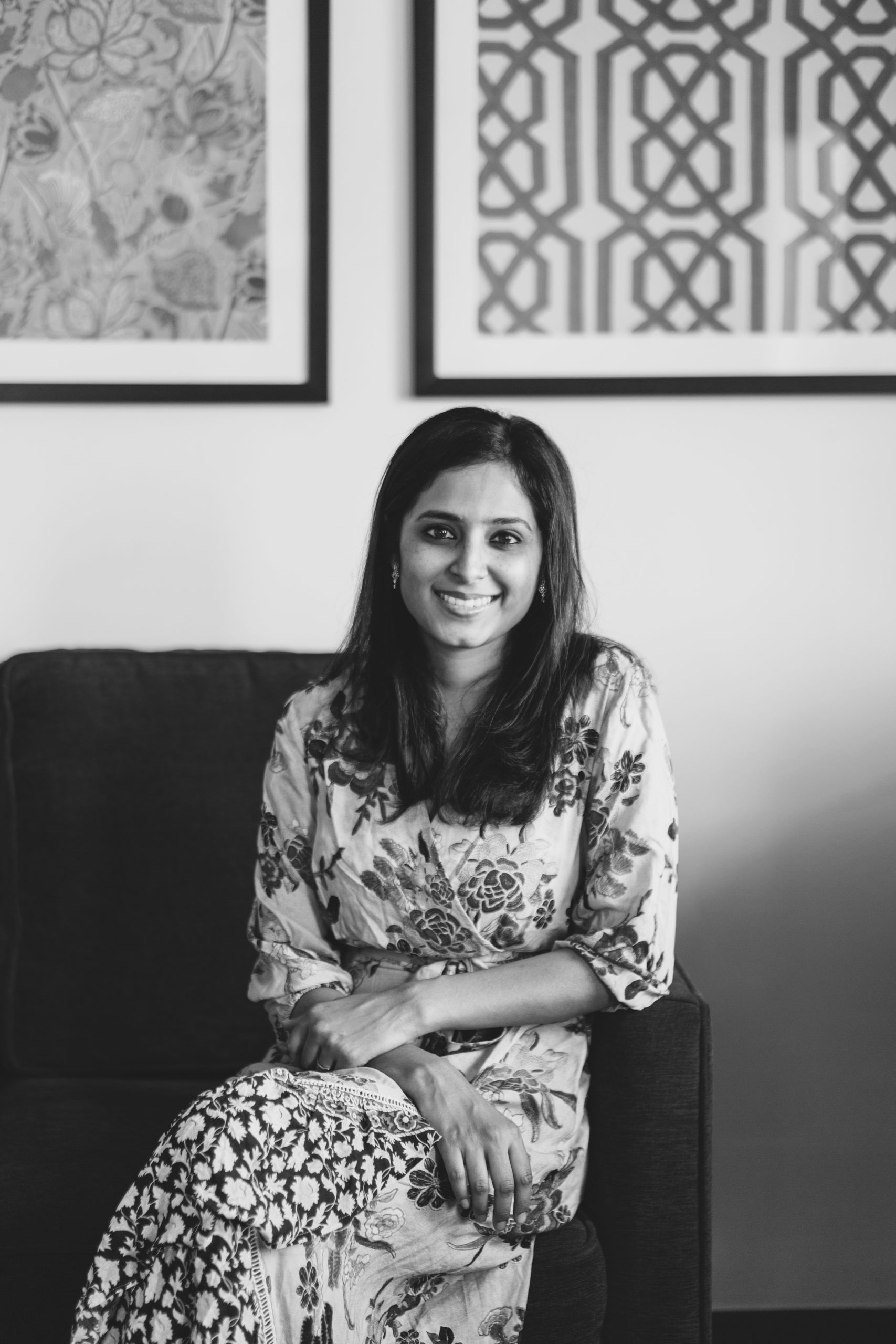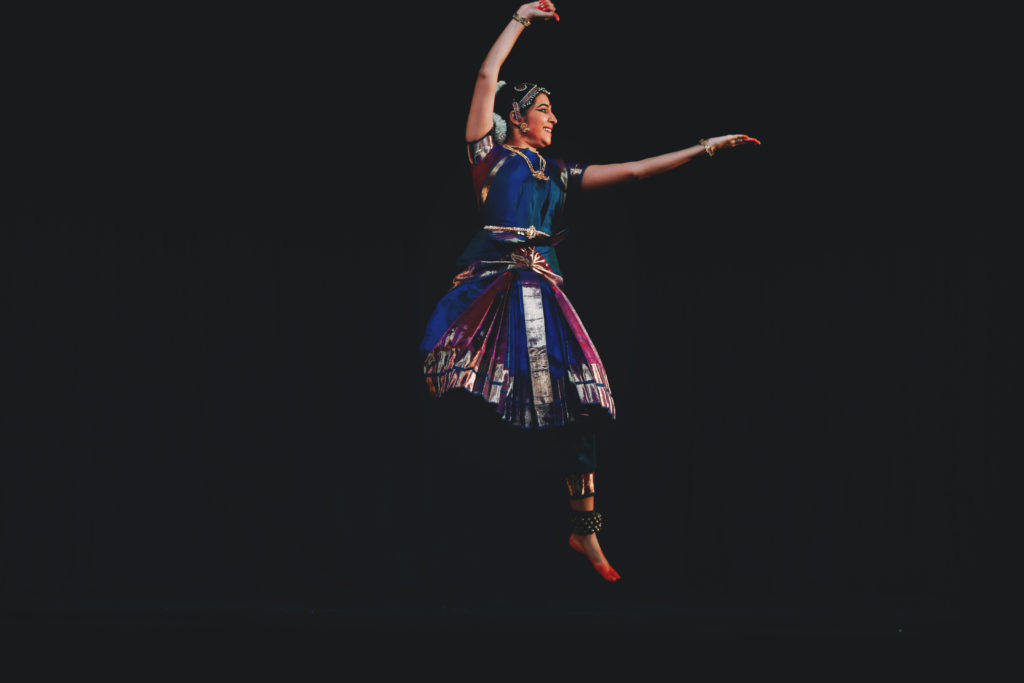
Photo by Manasi Mahesh
[ID: Preethi, black and white photograph of smiling young South Asian American woman with long dark hair in a floral dress, seated on a couch with arms crossed on her lap, the bottoms of two framed prints on the wall behind her.]
Bharatanatyam, a form of dance originating in South India, has rapidly gained a global reputation. With roots in temple ritual and salons passed from generation to generation through the hereditary dance and music community of Tamil Nadu, in post-colonial India, the practice began to attract students and performers from various backgrounds around the world as a performing art. While Bharatanatyam practitioners continue to navigate this history of shifts in performative practice, the art has now gained a serious fan following. With intricate movements, elaborate costuming, and intense training, its spheres of influence have grown to include everything from solo dancers to scholars to global touring ensembles.
I’ve loved Bharatanatyam from the moment my tiny feet set foot in my teacher’s studio in Chennai, India. It demands utmost focus from its students and performers, and as a barely seven-year-old girl visiting my grandparents, I was drawn to this commitment. In my early twenties, I was able to move to Chennai to pursue a career as a Bharatanatyam soloist, working intimately with many colleagues and choreographers, but focusing largely on my individual practice. Chennai seemed like the place to be, laden with historical remnants of Indian dance and music history. During the city’s famous “December Performance Season,” ensemble and solo artists of various genres come together in large performance auditoriums. But nothing enraptured me more than the Bharatanatyam soloists.

[ID: Profile of smiling Bharatanatyam dancer mid-leap in royal blue silk costume with gold trim and gold jewelry, ankle bells, right arm stretched overhead, left arm extended outward, right leg tucked under, left leg extended downward.]
During solo concerts, dancers perform up to seven compositions with varied themes and almost no breaks, for as long as an hour and a half. Some works of choreography are physically dynamic with catchy rhythmic sequences, while others require dancers to be more solitary using abhinaya, an expressive technique similar to miming. I rehearsed several hours a day and, after so much physical and emotional exertion, some performances would leave me with splitting headaches. Still, I embraced the solo Bharatanatyam dance as a career trajectory, covering up all evidence of effort—panting, sweat, pain—like all the dancers I admired. I didn’t think about dancing as labor, instead visualizing myself moving in glittering costumes for a rapt audience, pounding my feet on shiny wooden stages.
Several years later, when I moved back to the United States to be with my partner, I maintained the goal of being a soloist, but didn’t understand how to be a Bharatanatyam dancer here. While it has a vast audience in the United States, Bharatanatyam transmission and performance in this country is somewhat different from India. While India has more sabhas, performance organizations that provide spaces for dancers to perform, the United States offers avenues for artists to self-produce shows through grants and fellowship programs. India has a niche population of concert attendees for Indian dance, but selling tickets in the United States varies based on the population of Indian arts students and connoisseurs.
When I arrived in San Francisco, the local Bharatanatyam community opened up a new world for me, shifting my practice and perspective in the process. Sitting across from each other at the famous Nick’s Tacos, my friends and I began to ask, how can we imagine Bharatanatyam as having space for discussion and debate on politics, class, caste, gender, and sexuality? In critiquing one another during open rehearsals, we started to discuss the efforts, costs, and travel involved with Bharatanatyam and asked, how can we question these structures and support one another? Meaningful collaboration helped me to understand that Indian dance functions not just as performative practice but also as a form of labor.[1] These questions have now imbued my creative process, encouraging me to reflect on what I want to be dancing about right now, and how my work can respond to our fraught political world.
In late 2017, inspired by the SF Black Choreographers Festival, and at the urging of Joe Landini, I curated the first Indian Choreography Festival alongside Sri Thina and Shruti Abhishek. We called it When Eyes Speak in reference to the ways Indian dance engages the eyes to communicate narrative and emotional content. Our goal was to highlight the vastness of Indian choreography in its myriad forms, from Odissi to contemporary, for San Francisco audiences. Then, in May 2018, Shruti, Nadhi Thekkek, and I created Varnam Salons, facilitated intimate gatherings for dancers to share their work-in-progress versions of challenging compositions in the Bharatanatyam repertoire. With these spaces, we aim to eradicate the barriers between audience and performer in Indian dance, barriers that are strictly maintained on formal proscenium stages. We prioritize panel discussions, where the events run into lobby-talk and excited happy hours filled with chatter. Most importantly, we acknowledge the daily labor of artists, with compensation and technical support. Instead of stealthily wiping the sweat off to preserve layers of make-up for the stage, the salons feature dancers flushed with energy after sharing a challenging section of choreography with our intimate audience. Labor has always been intrinsic to Bharatanatyam practice, but what makes these collaborations meaningful is the acknowledgement of labor by way of artist, scholarly, and audience support.
In the middle of the global pandemic, many events moved to online platforms. With precise “tech rehearsals,” my collaborators and I held meeting after meeting to set up performance sessions online. I was worried about how the pandemic would shift the impact of live shows, but have been pleasantly surprised to see friends hanging onto Zoom calls until the very end. We have taken master classes, practiced technique, and watched online concerts together. As COVID-19 cases rose in India, we raised funds for organizations that we knew on the ground. I have shared new work online, bouncing ideas off colleagues on Whatsapp before turning to my infamous ring-light-tripod-and-smart-phone arrangement. This community has kept me sane for the past 14 months, and it has also grown. While there is a sufficient amount of care that I take with social media, I find comfort in my friends’ worlds, watching and sharing their work on my page, as we try to build our own critical dance worlds.
Collaboration has offered a subversive response to frustrating events ranging from COVID-19 to state-sanctioned violence. It has opened doors for me to see Bharatanatyam not from the perspective of individual career development, but rather the collective development of an artistic community. While I long to be on the stage again, I treasure these moments that have allowed me to see Bharatanatyam like an old friend in a new light for the very first time.
[1] I am greatly impacted by and draw on Priya Srinivasan’s text, Sweating Saris: Indian Dance as Transnational Labor (2011).
This article appeared in the Summer 2021 issue of In Dance.


